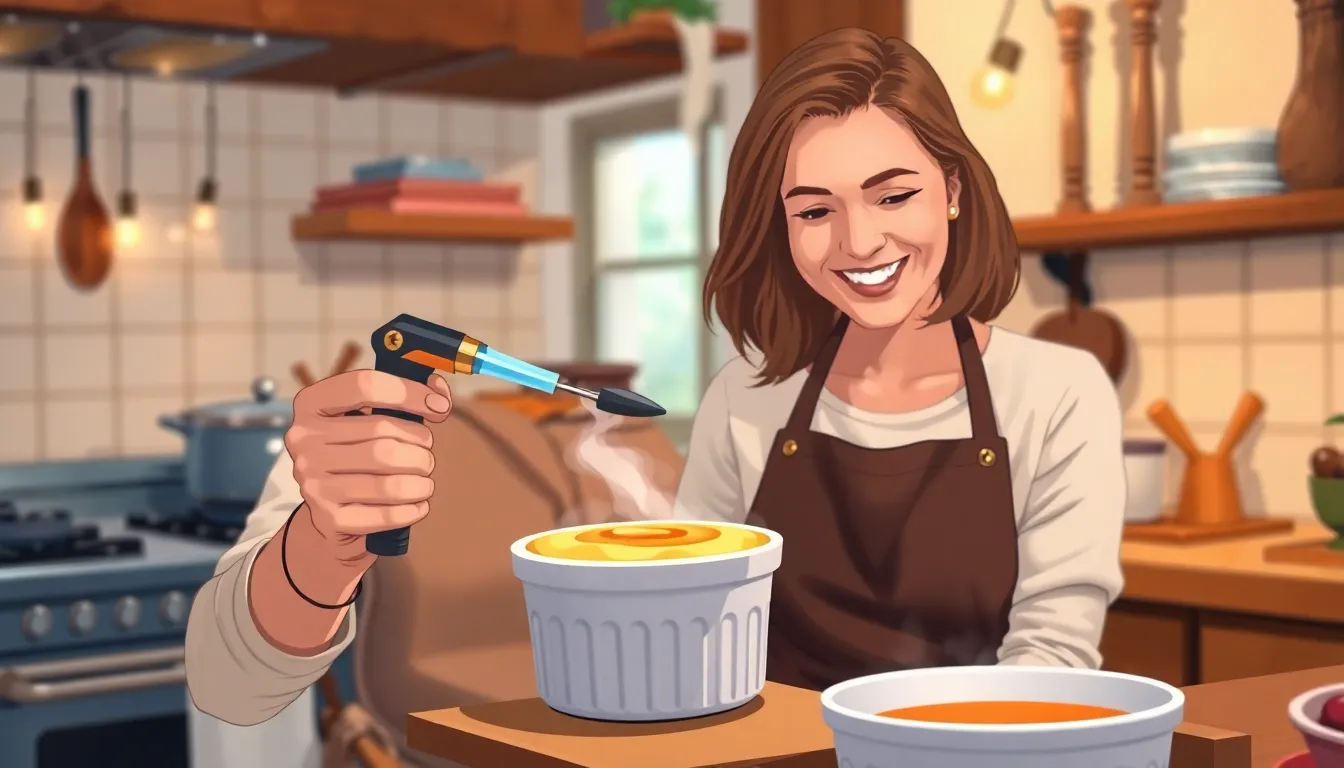Table of Contents
ToggleImagine the scene: a cozy evening at home, the aroma of vanilla wafting through the air, and the satisfying crack of caramelized sugar giving way to a creamy delight. That’s right, it’s time to conquer the art of making crème brûlée at home. This dessert is like a warm hug for your taste buds, and with just a few simple ingredients, you can impress your friends and family—or just treat yourself because you deserve it.
Ingredients Needed
To create a delicious crème brûlée at home, specific ingredients play a crucial role. Gather the following components for a successful recipe.
Cream and Sugar
Heavy cream provides the essential base for crème brûlée, contributing to its rich texture. Granulated sugar sweetens the mixture, balancing the cream’s flavor. Use about 2 cups of heavy cream and 1/2 cup of sugar. For the best results, opt for high-quality ingredients. Using fresh cream ensures a luxurious mouthfeel, while pure sugar adds the right amount of sweetness.
Flavorings
Vanilla extract serves as the primary flavoring in classic crème brûlée, but alternatives exist. Use one vanilla bean for maximum richness or approximately 1 to 2 teaspoons of vanilla extract for convenience. Brewed coffee or citrus zest can enhance the complexity of flavors. Incorporate these options according to personal preference for an even more personalized dessert.
Equipment
Tools and utensils are essential for crafting the perfect crème brûlée. A mixing bowl, whisk, and measuring cups are necessary for preparation. Ramekins help in baking and serving the dessert. Additionally, a kitchen torch allows for caramelizing the sugar topping. An oven or water bath setup aids in achieving the right texture, ensuring a smooth and creamy consistency.
Preparation Steps

Creating a perfect crème brûlée involves precise steps to ensure a smooth custard and a delightful finish. Follow these instructions closely for the best results.
Making the Custard
Start by combining 2 cups of heavy cream and 1/2 cup of granulated sugar in a mixing bowl. Whisk them together until the sugar dissolves. Add vanilla extract, or scrape a vanilla bean for a richer flavor. In a separate bowl, beat 5 egg yolks until they turn pale and thick. Gradually mix the warm cream mixture into the egg yolks while whisking continuously to prevent curdling. Pour the combined mixture through a fine sieve into ramekins. This step ensures a silky texture by removing any solids.
Chilling the Custard
Place the ramekins in the refrigerator after filling them. Chill them for at least 2 hours, allowing the custard to thicken properly. Cover them lightly with plastic wrap to prevent odor absorption. Ensure the custard is set before proceeding with the next step; it should have a slight jiggle in the center. Once chilled, they will provide a perfect base for caramelizing the sugar topping.
The Brûlée Process
Creating the perfect crème brûlée involves careful attention during the caramelization of sugar and crafting the ideal crust. These steps are essential for elevating the dessert’s overall appeal.
Caramelizing the Sugar
Caramelizing the sugar forms the signature crunchy topping. Using granulated sugar, sprinkle an even layer on top of the chilled custard. A kitchen torch works best for an even burn; maintain a distance of about 3 inches from the surface. Move the flame in a circular motion to prevent hot spots. Observe the sugar carefully as it melts and bubbles, transforming into a golden hue. After achieving the desired color, allow it to cool for a few minutes to set before serving.
Achieving the Perfect Crust
Achieving the ideal crust balances texture and flavor. A proper layer of sugar is crucial, with the recommendation of about 1-2 tablespoons per ramekin. Use high-quality granulated sugar for optimal caramelization. It’s important to ensure even coverage; no gaps should exist. The crust should crack when tapped gently, creating a delightful contrast to the creamy custard beneath. Avoid burning the sugar; this results in bitterness that detracts from the dessert’s sweetness.
Tips for Success
Making crème brûlée can be straightforward, but attention to detail ensures success.
Common Mistakes to Avoid
Overcooking the custard leads to a rubbery texture. Baking should occur at a low temperature for gentle cooking, typically around 325°F. Neglecting to strain the mixture results in a lumpy custard. Always strain to achieve a silky final product. Using too much sugar on top can cause excessive burning. About 1-2 tablespoons of sugar per ramekin guarantees the right balance. Caramelizing from too close distorts the desired texture, so maintain a distance of 3 inches while using the torch. Lastly, skipping the chilling step can compromise consistency, so refrigerate the custards for at least 2 hours before proceeding.
Variations to Try
Experimenting with flavors adds variety to this classic dessert. Adding citrus zest, such as lemon or orange, creates a refreshing twist. Infusing the cream with brewed coffee offers a rich, bold alternative. Incorporating spices like cinnamon or nutmeg introduces warmth and complexity. For a unique presentation, consider layering fresh fruit, like berries, under the custard. Chocolate lovers might enjoy adding cocoa powder for a decadent flavor. Lastly, substitute flavored extracts, such as almond or hazelnut, for a distinct taste experience.
Making crème brûlée at home is a rewarding culinary adventure. With the right ingredients and techniques anyone can impress guests or treat themselves to this classic dessert. The combination of creamy custard and a perfectly caramelized sugar crust creates an indulgence that’s hard to resist.
By following the outlined steps and tips it’s possible to master this elegant dish. Whether sticking to the traditional vanilla flavor or experimenting with unique variations there’s always room for creativity. The joy of cracking through that sugar layer to reveal the smooth custard beneath is a delightful experience that makes the effort worthwhile. So grab those ramekins and a kitchen torch and start creating this delicious masterpiece today.




